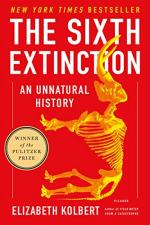|
This section contains 637 words (approx. 2 pages at 400 words per page) |

|
The Sixth Extinction Summary & Study Guide Description
The Sixth Extinction Summary & Study Guide includes comprehensive information and analysis to help you understand the book. This study guide contains the following sections:
This detailed literature summary also contains Topics for Discussion on The Sixth Extinction by Elizabeth Kolbert.
“The Sixth Extinction – An Unnatural History” by Elizabeth Kolbert is the story of the investigative journalist’s quest to discover if the Earth is undergoing the sixth time that the majority of species on earth are at risk or indeed headed for extinction. When Kolbert, who is a journalist and author who has an interest in man’s relationship with nature, read an article about the possibility that the Earth was headed for mass extinction, she got very interested and decided to see if she could answer that question.
Kolbert travels around the globe to seek resolution and to learn what signs of extinction there are, what species are endangered, what the possible causes are for the crisis, when did it start and what naturalists and scientist are doing to try to prevent as much loss and damage as possible. Her travels not only take her to spots around the globe where species are vanishing and scientists are working day and night to understand the phenomenon and diminish its impact, she travels back in time to learn about early scientists who first proclaimed that the extinction process existed. She describes the theories and explanations for extinction from these long-ago scientific researchers and naturalists.
In her information-gathering endeavor, she learns some basic things about extinctions. There is a natural extinction process that goes on virtually at all times. This type of extinction is called a “background extinction,” and like background noise no one other than scientists knows that it’s even occurring. The extinction of one species takes hundreds of years in this process which is why it is an unremarkable and invisible attrition of animals and plants. The background extinction is based on the theory of natural selection in which weaker species are ultimately pushed out by predation and loss of habitat and other natural occurrences including disease.
Although the weeding out of species in a “mass extinction” has occurred only a few times throughout the history of the Earth, the losses are swift and devastating. The extinction that is most familiar to everyone is the one that occurred at the end of the Cretaceous period when the dinosaurs were literally wiped out. Not many species from that time survived to the next geological period.
Another major difference between the two types of extinction processes is the “why” element of the event. While background extinctions are natural and on-going and do not cause a disturbance, mass extinctions are caused by cataclysmic events. Most scientists believe that the Cretaceous extinction was caused by the impact of a massive meteor that impacted the earth. There are unusually high traces of iridium around the globe which is one of the main elements of meteors. It is speculated that the meteor caused years of darkness and debris filled air that disallowed plant growth and killed off most species especially the largest of them which were the dinosaurs.
As Kolbert wades her way through eons of historical data, conflicting theories and today’s jungles and islands where extinction is at work, she begins to get a sense of the cause for the current mass extinction and learns that that same cause was behind mass extinctions in the past. Man is wired to explore and advance. In doing so, he has since the beginning of his existence disturbed the natural lives of other species. Global warming which is largely a result of man’s activity has caused the oceans to become acidified which presents a grave threat to the coral reefs of the world. The reefs are the apex species of the ocean’s ecosystem. If the reefs fail, so does the entire marine ecosystem. That failure – if it is not stopped or diminished – will lead to the destruction of other species that live on land and fly through the air.
Read more from the Study Guide
|
This section contains 637 words (approx. 2 pages at 400 words per page) |

|



